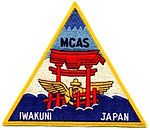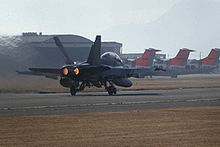- Marine Corps Air Station Iwakuni
-
MCAS Iwakuni 
MCAS Iwakuni logo IATA: none – ICAO: RJOI Summary Airport type Military Operator United States Marine Corps Location Iwakuni, Yamaguchi, Japan Built 1940 In use 1940 – present Commander Col. James C. Stewart[1] Occupants Marine Aircraft Group 12
VMFA(AW)-242
Marine Aviation Logistics Squadron 12
Marine Wing Support Squadron 171Elevation AMSL 10 ft / 3 m Coordinates 34°08′42″N 132°14′39″E / 34.145°N 132.24417°ECoordinates: 34°08′42″N 132°14′39″E / 34.145°N 132.24417°E Website Map Location in Japan Runways Direction Length Surface m ft 02/20A 2,440 8,005 Concrete Helipads Number Length Surface m ft 02H/20H 365 1,198 Concrete Sources: Official site[2]
Japanese AIP at AIS Japan[3]Marine Corps Air Station Iwakuni or MCAS Iwakuni (ICAO: RJOI) is a United States Marine Corps air station located in the Nishiki river delta, 1.3 NM (2.4 km; 1.5 mi) southeast of the Iwakuni Station[3] in the city of Iwakuni, Yamaguchi in Japan.
Contents
Tenant commands
- Marine Aircraft Group 12 (MAG-12) contains the rotary and fixed wing aircraft assets of Marine Corps Air Station Iwakuni. MAG-12 is home to four flying squadrons and a logistics Squadron.
- VMFA(AW)-242 — only permanent Marine F/A-18 Hornet fighter squadron stationed abroad.
- Marine Aviation Logistics Squadron 12 provides logistics support, guidance, and direction to MAG-12 and other commands aboard the Station. Click on the link to the right for more information on the Marauders.
- Marine Wing Support Squadron 171 provides essential Aviation Ground Support to the Station
- Headquarters and Headquarters Squadron provides administrative support and conducts training in general military skills for more than 800 Marines and sailors aboard MCAS Iwakuni.[4]
- Combat Logistics Company 36 Provides logistic support to MWSS-171 and MAG 12.
- 374th Airlift Wing 374th Communications Squadron provides communications support to H&HS, MAG-12, Branch Medical Clinic Iwakuni, Army Corps of Engineers, and JMSDF.
History
The Japanese government bought a large portion of what is today MCAS Iwakuni in 1938, with the view of establishing a naval air station. They commissioned the new base July 8, 1940. When World War II started, the Iwakuni air station was used as a training and defense base. The station housed 96 trainers and 150 Zero fighter planes on the airstrip. In September 1943, a branch of the Etajima Naval Academy was established here, with approximately 1,000 cadets undergoing training in the Basic, Junior and Senior Officer's schools at any one time. American B-29's bombed Iwakuni in May and August 1945, concentrating on the oil refinery and Rail Transport Office or train station areas. The last air raid took place just a day before the war was brought to a close.
The first allies to reach Iwakuni at the war's end were a group of U.S. Marines who had signed papers ending the conflict for the Japanese air base. After the end of World War II, various military forces from the United States, Britain, Australia, and New Zealand occupied the base and it was repaired by No. 5 Airfield Construction Squadron RAAF. It was designated a Royal Australian Air Force Base in 1948. Then in 1952, the base officially became a United States military base.[5]
The Americans first occupied the base in 1950 to use it as a springboard for aircraft heading to the Korean War.
It was revealed in 2010 that in 1966 nuclear weapons were moved to the base for storage from Okinawa. When U.S. ambassador to Japan Edwin O. Reischauer learned of the presence of the weapons, which was a violation of the Treaty of Mutual Cooperation and Security between the United States and Japan, he told the United States Department of State that if the weapons were not removed within 90 days he would resign and go public with the information. The weapons were removed shortly thereafter.[6]
On 14 July 1970, African-American soldiers and some anti-war soldiers raised a riot against the Vietnam War on the base.
It is currently home to around 5,000 United States Marines (including family members). The base is detailed for Marine pilot training and air patrol, using F/A-18 Hornet fighter-attack aircraft among others in compliance with the Treaty of Mutual Cooperation and Security obligations to protect Japan. MCAS Iwakuni is also shared with the Japanese Maritime Self Defense Force. MCAS Iwakuni has an air station that many people in Iwakuni want to be made into a public international airport. However as of 2009, it is only authorized for military use.[7]
MCAS Iwakuni is home to a Department of Defense school, Matthew C. Perry (Elementary and High School).
In 2014, it is planned to move the U.S. Carrier Air Wing from Atsugi to Iwakuni which will further increase the size of the base.[8]
The USMC's aircraft procurement plan for fiscal year 2010 revealed that the Corps plans to station 16 F-35B aircraft at Iwakuni beginning in the fall of 2015 to replace the AV-8 and F/A-18 aircraft currently stationed at the base. The F-35B's engines are louder than those of the AV-8 and F/A-18 which may have an impact on the local community.[9]
A new off-shore runway opened at the base on May 30, 2010. The new runway is 2,440 meters in length.[10]
Since 2000, the base has killed approximately 25,000 Black Widow spiders which apparently came to the base in cargo and luggage of Americans assigned to the base. The spiders are not native to Japan, so local American and Japanese authorities are attempting to keep them from spreading beyond the base. Two hundred three of the spiders were found and killed between October 2009 and January 2010.[11]
Commercial Services
Regular commercial service will start at the airport in 2012 with a civilian airport terminal built to accommodate commercial flights. It is projected that up to 430,000 passengers will use the airport.[12]
Destinations
- All Nippon Airways (Tokyo Haneda Airport, 4 daily starting 2012)
Friendship Day
Every year on 5 May, Japanese Nationals and U.S. service members, government employees and their families officially celebrate their long-standing friendship by opening the gates of MCAS Iwakuni for one of Japan's largest air shows dedicated to enhancing the friendship of the two nations. The event, entitled Friendship Day, hosts an average 250,000 visitors who travel from all over Japan.[13][14]
See also
References
- This article incorporates text in the public domain from the United States Marine Corps.
 This article incorporates public domain material from websites or documents of the Air Force Historical Research Agency.
This article incorporates public domain material from websites or documents of the Air Force Historical Research Agency.- ^ James C. Stewart
- ^ MCAS Iwakuni, official website. Retrieved 17 March 2010
- ^ a b AIS Japan
- ^ Headquarters and Headquarters Squadron
- ^ MCAS Iwakuni, Japan. (n.d.). MCAS Iwakuni History. Retrieved 17 March 2010, http://www.marines.mil/unit/mcasiwakuni/Pages/history.aspx
- ^ Jiji Press/Kyodo News, "U.S. kept nuclear arms at Iwakuni in 1966: scholar", Japan Times, March 17, 2010, p. 1.
- ^ Young Entrepreneur Club of the Iwakuni CCI. (2008). Reopen the Iwakuni International Airport Soon. Retrieved 11 January 2009, from http://www.icci.or.jp/yeg/kuko/gaiyou.html
- ^ Dae-woong, J. (2006, 15 September). The Korea Herald. Retrieved 11 January 2009, from Lexis Nexis Academic database.
- ^ Shimbun Akahata, "F-35B to be deployed to Iwakuni", 22 October 2009.
- ^ Japan Times, "New Offshore Runway At U.S. Iwakuni Operational", May 30, 2010.
- ^ Burke, Matthew M., and Elena Sugiyama, "Iwakuni battles to keep black widow spiders confined to base", Stars & Stripes, 7 June 2011.
- ^ Japan carrier to offer Iwakuni flights
- ^ {{cite press release BUT, in the year 2011, they decided to cancel Friendship Day (just for that year) because of the typhoon & tsunami up north. They thought it was sending a message that we were celebrating the tragedy. In my opinion, it would be best if we had still had Friendship Day (and added some type a booth to raise money for the people up north) because it would send a message that we want to extend our friendship towards the Japanese on this day and help them with what they were, and still are, going through. |accessdate=10 June 2008 |url=http://www.iwakuni.usmc.mil/press-releases/2008/016-08-conference.html |title=Press Conference for 2008 Friendship Day |date=8 April 2008 |publisher=MCAS Iwakuni, United States Marine Corps }}
- ^ "Friendship Day website" (in Japanese). http://www.friendship-day.net.
External links
- MCAS Iwakuni, official site
- Current weather for RJOI at NOAA/NWS
Japanese airports First class airports Chūbu Centrair International · Kansai International · Narita International · Osaka International (Itami) · Tokyo International (Haneda)Second class airports Third class airports Aguni · Amami · Aomori · Fukue · Fukui · Fukushima · Hachijojima · Hanamaki · Hateruma · Ibaraki (Hyakuri) · Iejima · Iki · New Ishigaki · Ishigaki · Iwami · Izumo · Kamigoto · Kerama · Kikai · Kitadaito · Kobe · Kōzushima · Kumejima · Matsumoto · Memanbetsu · Minami-Daito · Miyakejima · Miyako · Monbetsu · Nakashibetsu · Nanki-Shirahama · New Tanegashima · Niijima · Noto · Odate-Noshiro · Ojika · Okayama · Oki · Okinoerabu · Okushiri · Oshima · Rebun · Rishiri · Sado · Saga · Shimojishima · Shizuoka · Shonai · Tarama · Tokunoshima · Tottori · Toyama · Tsushima · Yakushima · Yonaguni · YoronOther airports Amakusa · Chofu · Hiroshima-Nishi · Honda · Kasaoka · Kōnan · Komatsu* · Makurazaki · Miho-Yonago* · Misawa Air Base/Misawa Airport* · Nagoya · Oitakenou · Okadama* · Tajima · Teshikaga · Tokushima*
(*: dual military/civilian use)Military only airfields Akeno · Asahikawa · Ashiya · Atsugi · Chitose · Futenma · Gifu · Hachinohe · Hamamatsu · Hōfu · Hyakuri · Iruma · Iwakuni · Kanoya · Matsushima · Metabaru · Iwo Jima · Kadena · Kasumigaura · Kasuminome · Kisarazu · Minami Torishima · Nyutabaru · Ōminato · Ozuki · Shimofusa · Shizuhama · Tachikawa · Tateyama · Tokachi · Tsuiki · Utsunomiya · YokotaHeliports Defunct airports Categories:- United States Marine Corps air stations
- Military bases of the United States in Japan
- Airports in Japan
- Transport in Yamaguchi Prefecture
- Airfields of the United States Army Air Forces in Occupied Japan
Wikimedia Foundation. 2010.



